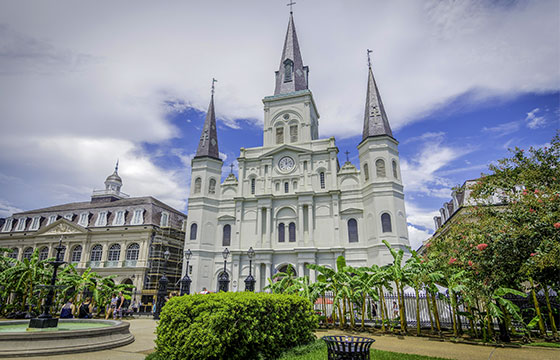Editor’s Note: New Orleans is a city that is considered to be one of the top tourist destinations in the United States, receiving almost 20 million tourists a year. One of those reasons is the unique architectural styles found throughout the city, such as French influence and shotgun homes. Another is the unique style of city planning that began in Jackson square and follows the form of the Mississippi River. The history of the unique architectural styles is something New Orleans natives and those who visit should be informed on — everything from street tiles to not-so-tall buildings. This piece on those 5 stunning location in New Orleans was originally Published on November 11th, 2021.
The Superdome was designed by Curtis and Davis as the largest fixed-dome in the world. In 1971, the Superdome first broke ground and was finished (and opened) in 1975. This fascinating structure hosts events of all kinds, including multiple Super Bowls, Boxing (Muhammad Ali defeated Leon Spinks in “September to Remember” at the Superdome, for any boxing fans out there), Music Festivals, and even a speech from Pope John Paul II in 1987. The Superdome is an essential part of New Orleans, especially after Hurricane Katrina. The site served as a refuge for over 30,000 locals who were affected by the storm in 2005. The Superdome is a must-see for anyone visiting or in New Orleans!
If you are interested in learning more about the Superdome, I would recommend visiting mbsuperdome.com and checking out the historical timeline!

One of the city’s most notable landmarks, St. Louis Cathedral which faces Jackson Square. (Photo: stlouiscathedral.org)
This is one of the oldest Cathedrals in the United States, built in 1789. The construction of this cathedral was dedicated to Louis IX, the King of France at the time. Sadly, the original structure (built in 1727) was burnt down in the Great New Orleans Fire of 1788. The Cathedral mixes the three architectural style of Renaissance, Gothic Revival, and Spanish Colonial to produce an interesting-looking but aesthetically pleasing building. Located right next to Jackson Square, it is in the center of the city, and has been a landmark for centuries. The Cathedral is open 9 am – 4 pm daily and offers tours as well as daily mass at 12:05 pm.
A steamboat captain, Captain Milton P. Doullut, designed himself a unique house that resembled the steamboats he guided back and forth on the river in 1905. In 1913, he built another house of similar style for his son, Paul. These houses were built on the highest land in the area and managed to survive the flooding post Hurricane Katrina in 2005. These two steamboat-resembling houses were designated as historic landmarks in 1977, but unfortunately, these houses are now privately owned and do not offer tours of the interior. You can still take a trip to see the exterior.

The beautiful looking Upper Pontalba Building, overlooking Jackson Square. (Photo: shushans.com)
Built in the late 1840s by the Baroness Micaela Almonester Pontalba, these apartment buildings are some of the most historically and architecturally significant structures in New Orleans. When construction of the upper row house buildings was completed in 1850, the Baroness and her sons moved in. The building is surrounded with elaborate looking balconies and intricate ironwork designed by the Baroness’s son, Gaston, that overlook the famous Jackson Square.

Gallier Hall, the City Hall for New Orleans from 1853 until the 1950s. (Photo: louisianadigitallibrary.org)
The Greek Revival styled building was finished in 1853 but was used by the police department during a pause in construction. First started in 1845, the city ran out of funding after completing the basement. The temporary solution was to put a roof over the basement and let the Police Department use the space while focusing on raising funds to complete Gallier Hall. In 1852, construction finally resumed and was complete by 1853. Gallier Hall served as City Hall for over 100 years until the 1950s when City Hall moved to Duncan Plaza.
All of these architectural sites add to the rich culture that is New Orleans. Each location has its own history that is encompassed in New Orleans as a whole. As a graduating Tulane student, I have taken a trip and visited each of these locations, and they are all stunning. I highly recommend anyone visiting to go and check out these sites!
Visiting these sites and sharing the information you learn at each of them can help foster interesting and informative conversation. Additionally, by sharing the historic information learned at each of these sites you are benefiting the New Orleans tourism industry.
Thanks for reading, now be sure to go out and explore all the wonderful buildings New Orleans has to offer!
 NOLAbeings Multimedia artist Claire Bangser created NOLAbeings as a portrait-based story project that marries...
NOLAbeings Multimedia artist Claire Bangser created NOLAbeings as a portrait-based story project that marries...  Voodoo in New Orleans: Reviving history: New Orleans fortune telling This article takes a deep dive into the history of Voodoo in New Orleans, its hybridization with Catholicism, and its present-day place in the city's culture. The author visits fortune-tellers in the French Quarter, using their guidance as a tool for introspection rather than a deterministic predictor of the future. Through her experiences in New Orleans, the author feels a mystical connection to both the past and the future.
Voodoo in New Orleans: Reviving history: New Orleans fortune telling This article takes a deep dive into the history of Voodoo in New Orleans, its hybridization with Catholicism, and its present-day place in the city's culture. The author visits fortune-tellers in the French Quarter, using their guidance as a tool for introspection rather than a deterministic predictor of the future. Through her experiences in New Orleans, the author feels a mystical connection to both the past and the future. 